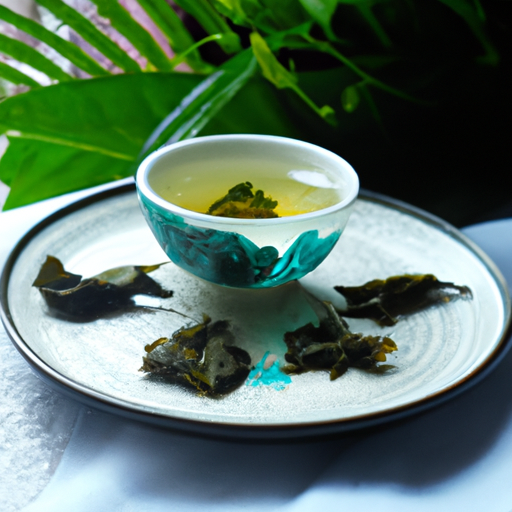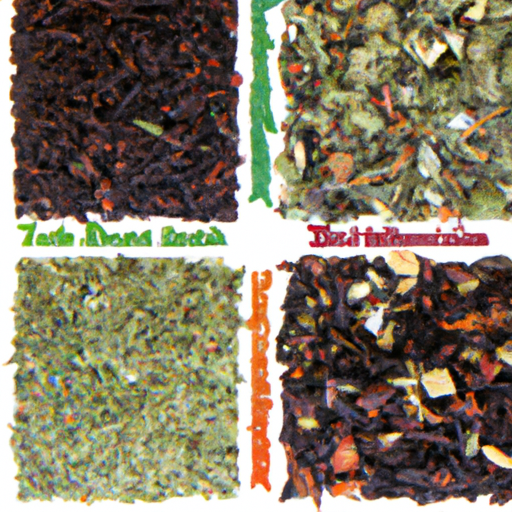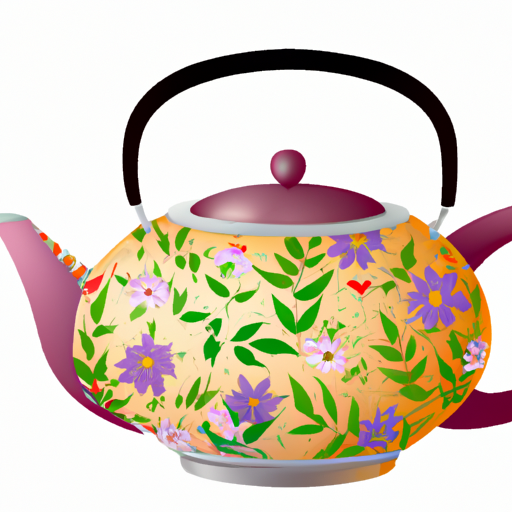Step into the enchanting world of green tea, where each sip transports you to a realm of delicate flavors and captivating aromas.
Like a gentle breeze on a sunny afternoon, green tea tantalizes the senses, awakening a sense of tranquility within. From the rolling hills of Japan to the majestic tea gardens of China, the journey begins with the Camellia sinensis tea plant, where nature weaves its magic.
With a myriad of varieties to explore, green tea unveils a symphony of flavors that dance upon the palate. Notes of freshness, sweetness, and a hint of bitterness intertwine, creating a harmonious melody that leaves a lasting impression.
Whether it’s the grassy undertones of sencha, the earthy allure of matcha, or the nutty embrace of genmaicha, there is a green tea to suit every discerning taste.
But selecting the perfect green tea is an art in itself. Leaf size, color, and the region of origin all play a role in unlocking the true essence of this celestial beverage. And once you’ve found your ideal brew, mastering the art of brewing is key to unlocking its full potential.
Join me on an exploration of the flavorful world of green tea, where every cup holds a story waiting to be savored.
Key Takeaways
- Green tea is a non-oxidized type of tea made from the Camellia sinensis tea plant.
- The flavor of green tea varies depending on the region where it is grown and can include freshness, vegetal notes, sweetness, bitterness, nuttiness, grassiness, smokiness, and seaweed notes.
- Japanese green teas are usually steamed, while Chinese green teas are pan-fired.
- Some popular green tea varieties include Japanese sencha, matcha, Genmaicha, and Chinese Dragon Well.
Types of Green Tea
I’ve learned that there are various types of green tea, such as Japanese sencha, matcha, gyokuro, and Chinese Dragon Well. Each type has its own unique flavor profiles and brewing methods.
These different green tea varieties offer a wide range of tastes and aromas, catering to different preferences. Japanese sencha is known for its fresh, green, and grassy flavor, while matcha offers a unique combination of sweet, bitter, and umami flavors. Gyokuro, on the other hand, is a shaded green tea with a savory umami taste that requires cooler water for brewing. Chinese Dragon Well is popular for its flat leaves and slightly nutty and sweet flavor.
Apart from their distinct flavors, green teas also boast numerous health benefits. They have antioxidant properties, potential weight loss support, and can improve brain function.
Incorporating these different green tea varieties into your daily routine can be a flavorful way to enhance your well-being.
Production and Processing
During the production and processing of this beloved beverage, the tea leaves undergo a series of carefully orchestrated steps that ultimately determine their flavor and aroma. The history of green tea production dates back thousands of years, with China being the birthplace of this ancient tradition. Today, both Japan and China are renowned for their green tea production, each with their unique methods and flavors.
The production process involves several key steps, including harvesting, withering, the kill-green step, rolling/shaping, and drying. Japanese green teas are typically steamed, while Chinese green teas are pan-fired. These different processing methods contribute to the distinct flavors and characteristics of each tea.
Green tea is not only a delicious beverage but also offers numerous health benefits. It is rich in antioxidants, which help protect the body against free radicals and reduce the risk of chronic diseases. Green tea also contains caffeine, which can provide a gentle energy boost and improve focus. Additionally, studies have suggested that green tea may aid in weight loss, improve heart health, and support brain function.
| Production Steps | Flavor Contribution |
|---|---|
| Harvesting | Determines the maturity of the leaves and affects the flavor profiles |
| Withering | Allows moisture to evaporate and enhances the tea’s aroma |
| Kill-green step | Halts oxidation and preserves the tea’s green color |
| Rolling/Shaping | Determines the shape of the tea leaves and affects the infusion process |
| Drying | Removes remaining moisture and stabilizes the tea for storage |
The production and processing of green tea is a meticulous and fascinating process that has been refined over centuries. Understanding the history and methods behind green tea production allows us to appreciate the nuances and flavors that make each cup so unique. Moreover, incorporating green tea into our daily routine can provide us with not only a flavorful experience but also a range of health benefits.
Flavor Profiles
When exploring different types of green tea, it’s fascinating to discover the diverse range of flavor profiles they offer. Green tea is known for its fresh, vegetal notes, but there are many other flavors to be found.
Here are three flavor profiles that you can explore when enjoying green tea:
-
Sweetness: Some green teas have a natural sweetness that’s reminiscent of fruits or honey. These teas are perfect for those who prefer a sweeter flavor profile and can be enjoyed on their own or used in green tea recipes like smoothies or desserts.
-
Nuttiness: Green teas with a nutty flavor profile often have hints of almond, chestnut, or roasted grains. These teas are great for those who enjoy a richer, more complex flavor and can be paired with savory dishes or enjoyed on their own.
-
Floral: Many green teas have delicate floral notes that add a touch of elegance to every sip. Jasmine green tea is a classic example, with its fragrant aroma and subtle floral flavors. These teas are perfect for relaxation and can be enjoyed hot or cold.
In addition to their delicious flavors, green teas also offer numerous health benefits. They’re rich in antioxidants, which can help protect against chronic diseases. Green tea is also known to boost metabolism and aid in weight loss. Its calming properties can help reduce stress and improve mental clarity.
So, the next time you brew a cup of green tea, take a moment to savor its unique flavor profile and reap the benefits it has to offer.
Choosing and Brewing Tips
To choose the perfect green tea, consider the flavor, leaf size, and color, as they can provide valuable insights into the tea’s characteristics. Green tea comes in a variety of flavors, ranging from fresh and vegetal to nutty and smoky. The leaf size and color can also indicate the taste and aroma of the tea. For example, smaller leaves tend to produce a more delicate and subtle flavor, while larger leaves can result in a stronger and bolder taste. Additionally, the color of the leaves can give you an idea of the tea’s freshness and quality.
To help you navigate the world of green tea, here’s a helpful table:
| Flavor Profile | Leaf Size | Leaf Color |
|---|---|---|
| Fresh and Green | Small | Bright Green |
| Nutty and Sweet | Medium | Dark Green |
| Smoky and Bold | Large | Olive Green |
| Floral and Light | Rolled | Light Green |
In addition to its delicious flavors, green tea offers numerous health benefits. It is rich in antioxidants, which can help protect against chronic diseases. Green tea has also been associated with weight loss, as it may help boost metabolism and fat burning. However, it’s important to note that while green tea can be a helpful addition to a healthy lifestyle, it is not a magic solution for weight loss. As always, it’s best to consult with a healthcare professional before making any significant changes to your diet or exercise routine.
Frequently Asked Questions
Does green tea have any health benefits?
Green tea has numerous health benefits. It is known to promote heart health by reducing the risk of heart disease. This is due to its antioxidant properties, which help protect against oxidative stress and inflammation.
What is the difference between Japanese and Chinese green teas?
Japanese and Chinese green teas have distinct flavor profiles. Japanese green teas, like sencha and matcha, have fresh, grassy flavors. Chinese green teas, such as Dragon Well and Chunmee, are smoky and nutty. The brewing techniques also vary, with Japanese teas being steamed and Chinese teas being pan-fired.
Can green tea help with weight loss?
Green tea can potentially aid in weight loss through its effects on metabolism and appetite suppression. Studies suggest that the catechins and caffeine in green tea can increase metabolism and reduce appetite, contributing to weight management.
Are there any green teas that are naturally caffeine-free?
Yes, there are green teas that are naturally caffeine-free. Herbal alternatives like chamomile, peppermint, and rooibos are great options. However, it’s important to note that true green tea, made from Camellia sinensis, contains caffeine.
How should green tea be stored to maintain its freshness?
To maintain the freshness and flavor of green tea, store it in an airtight container away from light, heat, moisture, and strong odors. Use opaque containers or tin cans, and avoid plastic bags. This will prevent oxidation and prolong its shelf life, preserving the aroma.
Conclusion
In conclusion, green tea is a fascinating and diverse beverage that offers a wide range of flavors and profiles. From the freshness and vegetal notes of sencha to the nuttiness and grassiness of Dragon Well, there is a green tea to suit every palate.
It’s interesting to note that green tea production has increased by 50% over the past decade, with more and more people discovering its health benefits and unique taste.
So why not join the growing number of green tea enthusiasts and explore the flavorful world of green tea today?










